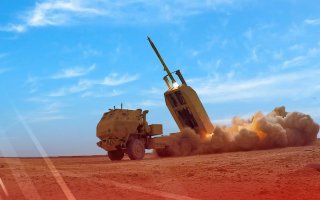Is the U.S. Army Ready to Sink Enemy Ships?
The Precision Strike Missile will be able to hit targets out at sea.
Here's What You Need to Know: The Army plans to fire PrSMs during its Project Convergence 2021.
The Army envisions its emerging and now-in-development 500km-ranged Precision Strike Missile (PrSM) as a unique and potentially breakthrough multi-domain weapon system able to destroy enemy air defenses and even surface ships at great distances.
Service weapons developers, many of whom see the PrSM as a critical and fast-evolving innovation, are already expanding their vision for the weapon and looking beyond its near-term mission scope.
“We are thinking past 2023 and thinking about how we’re going to use the Precision Strike Missile to hit ships and air defenses,” Brig. Gen. John Rafferty, Director, Long Range Precision Fires Cross Functional Team, Army Futures Command, told The National Interest in an interview.
As part of this equation, the Army is now configuring the weapon such that two missiles can go into the same launch-pod container, a circumstance which could increase tactical mobility as well as the rate of fire in terms of optimizing effects on target. The service plans several upcoming tests at White Sands Missile Range, New Mexico, and Vandenberg Air Force Base, California where there might be more range options.
“We are continuing to increase the complexity of the challenges of each test event as we go along,” Rafferty said.
Later this year, the Army plans to fire PrSMs during its Project Convergence 2021, an exercise intended to experiment with cutting edge kinds of innovations aimed at using artificial intelligence-enabled computing to instantly analyze information, share target data and pair sensors with shooters. This concept was demonstrated last Fall at the Army’s Project Convergence 2020.
In a discussion with The National Interest, Army Futures Command Commander Gen. John Murray explained that the PrSM will figure prominently in networking, sensing and AI-targeting scenarios envisioned for Project Convergence 2021, particularly when it comes to multi-node, multi-sensor targeting and attack. The intent is to link PrSM targeting sensors with air assets, maritime nodes and dispersed or otherwise disconnected ground units. Project Convergence, Murray emphasized, is intended to be an “experiment” or “learning exercise” to push the envelope of technological possibility and, ultimately, change the paradigm for modern warfare and Combined Arms Maneuver. The objective, which was accomplished in many respects during Project Convergence 2020, was to reduce the sensor-to-shooter targeting decision cycle from twenty minutes down to seconds. Despite the apparent success of Project Convergence, which some observers referred to as a breakthrough, Murray made a point to say the effort is very much an “ongoing experiment” and “learning process.”
“In the future, we want to bring in more shooters and kind of expand. And it’s about scaling, right? So, you know, how, how far can we expand the network? How far can we expand their scale in the number of shooters we bring? And how far can we scale the number of sensors? Because you’re gonna reach an upper boundary at some point. And so what is that upper boundary? And you know, how does that work in a contested environment?” Murray said.
When coupled with the kind of multi-node sensor-to-shooter pairing described by Murray, the PrSM brings first-of-its-kind multi-domain attack possibilities to dispersed areas such as the Pacific, Rafferty said.
“The long term missile solution for the Army to attack all domains including maritime and land is PrSM,” Rafferty said.
Kris Osborn is the defense editor for the National Interest. Osborn previously served at the Pentagon as a Highly Qualified Expert with the Office of the Assistant Secretary of the Army—Acquisition, Logistics & Technology. Osborn has also worked as an anchor and on-air military specialist at national TV networks. He has appeared as a guest military expert on Fox News, MSNBC, The Military Channel, and The History Channel. He also has a Masters Degree in Comparative Literature from Columbia University.
This article first appeared in March 2021.
Image: Lockheed Martin

